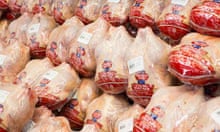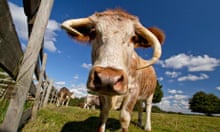This week's papers have once again been filled with stories about how we should eat less meat. But are we already consuming less than we used to? How do we compare to other countries?
Historical trends in UK meat consumption
Using detailed statistics that Defra publishes each year on families' food, we're able to look at the quantities that the average person consumes per week. What's more, the data goes back as far as 1974 and covers everything from pickles to pizza.
There are some fascinating facts hidden in these numbers - such as that the average Brit consumed just 12ml of mineral water per week in 1983 which has since soared to 256 ml - partly because the products listed are so detailed. As a result, we can disaggregate some of our conclusions about demand for meat in the UK.
Looking at the decade of most recent data, it appears that our consumption of meat has fallen by 13% since 2007. But the trends actually differ considerably between varieties of meat and meat products.
The average person in the UK will buy 8g of takeaway kebab this week. What about the much loved sausage roll that was at the heart of our recent ? Well, we bought 12g of sausage roll in 2011 - meaning that the average Brit ate roughly 4 of these snacks a year.
We now purchase more chicken than ever before - 190g of the stuff per person per week, compared to a mere 115g in 1974. By contrast uncooked bacon and ham appear to be disappearing from our plate - although purchases of cooked bacon and ham have risen steadily.
It's not just that on the whole we're buying less meat to eat at home - we're also purchasing less in the form of takeaways and restaurant meals. Defra hasn't been collecting this data for long but it does show that we're buying 20% less meat when we eat out than we did in 2001.
Brits bought 16g of take-away and restaurant burgers in 2011 outside their homes, compared to 25g in 2001 - and given the horsemeat scandal of this year, it's likely that the next release will show an even bigger decline.
Meat and money
As well as changing appetites, demand for meat in the UK might be influenced by economic factors that affect household income. We looked at the data on UK GDP growth and compared it to the quantities of meat that households purchase.
There does appear to be some correlation. Take, for example, 2008 - households bought 11.5% less carcase meat than they did in 2007 while GDP also fell by 1%. Similarly, in 1981 and 1992 drops in demand coincide with drops in GDP - and looking at 1985 and 2000, the increases occur simultaneously too.
World trends
So how do UK carnivores compare to their international counterparts? The Food and Agriculture Organization of the United Nations (FAO) publishes data about the average amount of meat consumed per person for almost every country in the world.
While it's true that wealthier countries do, on average, consume more meat, there are some notable exceptions. The average Brazilian consumed about the same amount of meat as the average Frenchman did in 2009, despite Brazil having a GDP per capita less than a third that of France.
The biggest meat eaters are to be found in the U.S. where 127kg was consumed per person in 2007. New Zealand and Australia are also big meat eaters, while Spain tops the list for Europe. Britain's meat consumption, at 84.2 kg per person per year is relatively consistent with its neighbours in Ireland (87.9 kg), France (86.7 kg) and Germany (88.1 kg).
You can click on the countries in the map below to see changes over time.
Did you find this data useful? Would you like to know if we're consuming more calories than ever before? Which countries eat the most cheese? What about whether global health patterns correlate with meat consumption?
We have datasets on these trends so just let us know by posting a comment below, tweeting to @MonaChalabi or @GuardianData or via email at data@guardian.co.uk
Download the data
DATA: download the full spreadsheet
More open data
Data journalism and data visualisations from the Guardian
Can you do something with this data?
Flickr Please post your visualisations and mash-ups on our Flickr group
Contact us at data@guardian.co.uk




Comments (…)
Sign in or create your Guardian account to join the discussion